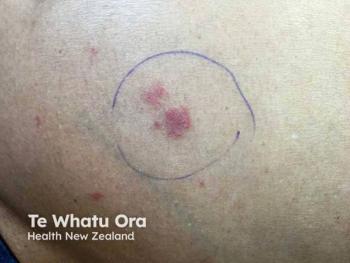
Racial Differences of AD Characteristics in US Patients
A poster presentation from the 2022 RAD Conference analyzed manifestations of atopic dermatitis across racial groups.
Study authors of a poster presentation from the 2022 virtual Revolutionizing Atopic Dermatitis Conference examined the racial differences of atopic dermatitis (AD) characteristics in a diverse outpatient cohort in the United States. AD is known to present differently across racial groups, and it is crucial for physicians to recognize specific heterogeneous manifestations across varying racial groups. Due to limited knowledge about how commonly distinctive features of AD appear by race, the study authors aimed to assess racial differences in the proportions of select key features of AD.
Methods of study included analyzing the health care claims database from a large metropolitan tertiary care medical center for patients with physician-diagnosed AD using International Classification of Disease, Tenth Revision, Clinical Modification codes L20.x. Patient medical records were reviewed for demographics, comorbidities, and documentation of Hanifin-Rajka diagnostic criteria. The frequency of each criterion was evaluated by race: White, Black, Asian, and Multiracial/Other.
The study included 766 patients with AD; 374 (48.8%) were White, 284 (37.1%) were Black, 89 (11.6%) were Asian, and 19 (2.5%) were multiracial/other, 558 (68.2%) were female, 50 (6.1%) were age <18 years, 456 (55.7%) were between 18-49 years old, and 313 (38.2%) were aged 50 years or older.
Compared to White patients with AD, Black patients had statistically significant higher proportions of personal (81.4% vs. 57.3%) and family (63.3% vs. 42.2%) history of AD, perifollicular accentuation (60.6% vs. 36.9%), and xerosis on physical exam (84.2% vs 73.9%).
Multiracial/Other patients had elevated proportions of history of dry skin (81.3%), xerosis on physical exam (86.7%), and elevated immunoglobulin E levels (75.0%). Black and Multiracial/Other patients had higher rates of food hypersensitivity compared to White patients (50.0% and 71.4% vs. 35.1%).
Asian patients had marginally significant differences compared to White patients in the proportions of early-age onset of AD (56.9% vs. 41.8%) and anterior neck fold involvement (42.6% vs. 25.3%).
There were no significant racial differences in the likelihood of other Hanifin-Rajka criteria, including pruritus, flexural dermatitis, chronic dermatitis, ichthyosis, nipple eczema, hand/foot dermatitis, immediate skin reactivity, subcapsular cataracts, cutaneous infections, pruritus when sweating, intolerance to wool/lipid solvents, environmental/emotional factors worsening AD, or white dermatographism.
Overall, the study results demonstrate that there are racial differences of AD characteristics within a diverse patient-cohort from an academic medical center in the United States. Racial differences of AD characteristics may be related to population differences of genetics, environmental exposures, skin care practices, and other factors.
Reference
- Sanfilippo E, Iyer S, Patel N, et al. Assessment of racial differences of atopic dermatitis characteristics in a diverse outpatientcohort in the united states. Poster presented at: RAD 2022 Conference; December 11, 2022;
https://djbpnesxepydt.cloudfront.net/radv/December2022/Dec2022Posters/313_AD-Criteria-by-Race_Sanfilippo-et-al_Poster_1670623027222.pdf .
Newsletter
Like what you’re reading? Subscribe to Dermatology Times for weekly updates on therapies, innovations, and real-world practice tips.


















